
Book 2. High beginning grammar book in a 5-level series for ESL students. This is the second of the two books for beginners.
- Subject:
- English Language Arts
- Material Type:
- Homework/Assignment
- Textbook
- Date Added:
- 05/26/2016

Book 2. High beginning grammar book in a 5-level series for ESL students. This is the second of the two books for beginners.

Book 4. High intermediate grammar book in a 5-level series for ESL students. This is the second of the two books for intermediate students.

Book 3. Low intermediate grammar book in a 5-level series for ESL students. This is the first of the two books for intermediate students.

An explanation of how and when to use the ellipsis.

The 12th grade learning experience consists of 7 mostly month-long units aligned to the Common Core State Standards, with available course material for teachers and students easily accessible online. Over the course of the year there is a steady progression in text complexity levels, sophistication of writing tasks, speaking and listening activities, and increased opportunities for independent and collaborative work. Rubrics and student models accompany many writing assignments.Throughout the 12th grade year, in addition to the Common Read texts that the whole class reads together, students each select an Independent Reading book and engage with peers in group Book Talks. Language study is embedded in every 12th grade unit as students use annotation to closely review aspects of each text. Teacher resources provide additional materials to support each unit.

In our lives, we are constantly telling stories to ourselves and to others in an attempt to both understand our experiences and present our best selves to others. But how do we tell a story about ourselves that is both true and positive? How do we hold ourselves up in the best possible light, while still being honest about our struggles and our flaws? Students will explore ways of interpreting and portraying personal experiences. They'll read Chinua Achebe's novel Things Fall Apart , analyzing the text through the eyes of one character. They'll get to know that character's flaws and strengths, and they'll tell part of the story from that character's perspective, doing their best to tell an honest tale that presents their character's best side. Then they'll explore their own stories, crafting a personal narrative about an important moment of learning in his or her life.
ACCOMPLISHMENTS
Students read and analyze Chinua Achebe’s Things Fall Apart , viewing the events and conflicts of the novel through the eyes of one of the central characters.
Students write a two-part narrative project: one narrative told through their character’s perspective and one personal narrative about an incident in their own life.
GUIDING QUESTIONS
These questions are a guide to stimulate thinking, discussion, and writing on the themes and ideas in the unit. For complete and thoughtful answers and for meaningful discussions, students must use evidence based on careful reading of the texts.
How do our conflicts shape and show our character?
How can we tell a story about ourselves that’s both honest and positive?
How do definitions of justice change depending on the culture you live in?
What are ways individuals can react to a changing world? To a community that doesn’t accept us?
BENCHMARK ASSESSMENT: Cold Read
During this unit, on a day of your choosing, we recommend you administer a Cold Read to assess students’ reading comprehension. For this assessment, students read a text they have never seen before and then respond to multiple-choice and constructed-response questions. The assessment is not included in this course materials.
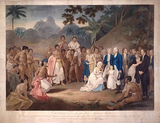
In this lesson, students will work with their writing groups to revise the first draft of their narrative, looking closely at descriptive language, as well as introductions and conclusions.

This lesson provides an interactive, fun way to learn proper grammar and punctuation. Utilizing multimedia and technology-based platform, the game will use engaging and relatable everyday scenarios to learn about proper grammar and punctuation for application in speech and writing. The DLO focuses on the target audience of female learners 15-24 years of age who will be exposed to real-world applications for the information which they are learning, explicitly tailored to increase literacy skills on multiple levels. The problems and scenarios that are given are realistic, allowing learners to refer to personal, relevant experiences to use as a reference when experiencing similar scenarios. For rationale and defense, this relevance is also reinforced in the instruction by Dr. Rodgers. This DLO is designed to take learners through a media-based “Leo City,” where they will experience different levels of grammar activities with each character they meet in the world. As the learner improves their skills, their character will also power up and gain powers to be able to gain access to new sections of the city, until they reached the end.
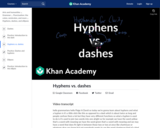
A comparison of hyphens and dashes.

Apostrophes are great at standing in for missing letters, allowing us to shorten words. Paige and David discuss contractions and the Principle of Least Effort.
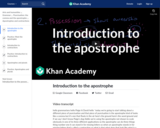
David and Paige, KA’s resident grammarians, introduce a new piece of punctuation: the apostrophe!
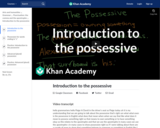
Apostrophes can help show when something belongs to someone. Paige and David explain how!
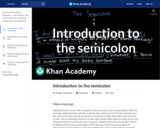
Paige introduces a piece of punctuation called the semicolon; this punctuation can link closely related independent clauses together in a sentence. Created by David Rheinstrom.

A freshman composition textbook used by the English Department of Virginia Western Community College (VWCC) in Roanoke, Virginia. It aligns with ENG 111, the standard first-year composition course in the Virginia Community College System (VCCS). The ten chapter headings are:
1. Chapter 1 - Critical Reading
2. Chapter 2 - Rhetorical Analysis
3. Chapter 3 - Argument
4. Chapter 4 - The Writing Process
5. Chapter 5 - Rhetorical Modes
6. Chapter 6 - Finding and Using Outside Sources
7. Chapter 7 - How and Why to Cite
8. Chapter 8 - Writing Basics: What Makes a Good Sentence?
9. Chapter 9 - Punctuation
10. Chapter 10 - Working With Words: Which Word is Right?
This book was created by the English faculty and librarians of VWCC using Creative Commons -licensed materials and original contributions.
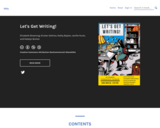
The layout of our book implies there is a beginning, middle, and end to a writing course, but because writing is both an art and a skill, people will find their own processes for learning, improving, and using these skills. Writing processes differ because we are each looking for a workable schemata that fits our way of thinking. Try out a variety of writing processes and strategies, and find what works for you. If you are not uncomfortable on this journey, you simply are not stretching yet.
A quick glance through the book will show you that it deftly covers the basics, which are always important to review as you get ready to build onto your scaffolding. Reminders of terminology that form the foundation of a discipline—as well as explanations, descriptions, and examples of their use in a basic education—are in chapters such as “Critical Reading,” “Writing Basics: What Makes a Good Sentence,” “The Writing Process,” “Punctuation,” and “Working with Words.” These are, of course, fundamentals that you have worked with throughout your education, learning in each course skills and habits that elevate your reading, writing, and thinking abilities. This college writing course will ensure that you take another step up to college and professional writing.
This text is different in its emphasis on research skills and research writing. The form you will learn, the building blocks of that form, the formality, and the sacrosanct crediting of sources is explained here from English professors and our instructional librarian at the college. Leaning on questions that lead to searches for answers that lead to arguments that present your understanding, the chapters “Critical Reading,” “Rhetorical Modes,” and “Argument” will fill out your growing appreciation of and comfort with the research form in everyday life. From the discussion of source types to guidance through the research process to the models of essay deconstruction, you will find that the expectations and language of this text begin with the college-level student in mind.
Working through this text will elevate you into the next stage of writing for a 21st century student and professional.
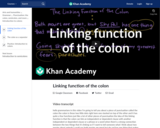
KA grammarian Paige introduces an important piece of punctuation that helps link items in a sentence: the colon!
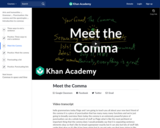
David and Paige introduce you to the superhero of the punctuation world: the comma!
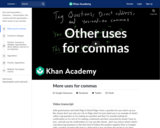
David and Paige, KA’s resident grammarians, discuss tag questions, yes and no statements, and direct address -- all situations where the comma is super useful.
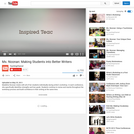
Madeline Noonan meets with all of her students individually during writer's workshop. In each conference, she specifically identifies strengths and two goals. Students continue to revise and rewrite throughout the workshop process and build confidence in their writing at the same time.

Parentheses set off extra information (such as a writer's remarks, an interruption, or a reference) from the rest of a sentence. Learn how to use them in this video!